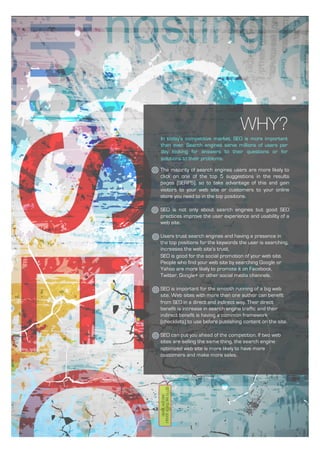A Guide to SEO
- 2. WHAT? SEARCH ENGINE OPTIMISATION Search engine optimization or SEO in short, is a set of rules that can be followed by website (or blog) owners to optimize their websites for search engines and thus improve their search engine rankings. In addition, it is a great way to increase the quality of their web sites by making them user- friendly, faster and easier to navigate. For beginners to SEO the above definition may sound complicated, in simpler terms SEO is a way to improve your website so that it will appear closer to the top positions in the search results of Google, Yahoo, Bing or other search engines. SEO can also be considered as a framework since the whole process has a number of rules (or guidelines), a number of stages and a set of controls.
- 3. WHY? In today’s competitive market, SEO is more important than ever. Search engines serve millions of users per day looking for answers to their questions or for solutions to their problems. The majority of search engines users are more likely to click on one of the top 5 suggestions in the results pages (SERPS), so to take advantage of this and gain visitors to your web site or customers to your online store you need to in the top positions. SEO is not only about search engines but good SEO practices improve the user experience and usability of a web site. Users trust search engines and having a presence in the top positions for the keywords the user is searching, increases the web site’s trust. SEO is good for the social promotion of your web site. People who find your web site by searching Google or Yahoo are more likely to promote it on Facebook, Twitter, Google+ or other social media channels. SEO is important for the smooth running of a big web site. Web sites with more than one author can benefit from SEO in a direct and indirect way. Their direct benefit is increase in search engine traffic and their indirect benefit is having a common framework (checklists) to use before publishing content on the site. SEO can put you ahead of the competition. If two web sites are selling the same thing, the search engine optimized web site is more likely to have more customers and make more sales.
- 4. 15 STEP GUIDE OPTIMISE YOUR SITE Use Google Webmaster tools to characterise your site. It will provide you with basic information about your site’s performance, security issues, how users are finding the site via search and the keywords that they’re using. It’s a good place to start. Onsite audits are typically the domain of technical teams but it's a straightforward task to undertake a site audit using tools such as Google Webmaster Tools or Screaming Frog and identify any issues that may be sub-optimal. Site speed, site map, broken links and poor Meta data are all common issues. Addressing these may result in an immediate performance boost. Define your goal but be realistic. If you want to get to the top page of a Google search for a fiercely competitive term, recognise that you've got a big challenge. Think about the markets you operate in, who your prospects and customers are, and consider the topics and issues that are relevant to them. “Understand whether you have a chance of ranking before you start. The SEO competition module in Market Samurai is a key tool. Fight the battles you have a chance of winning,” said Escherman’s Andrew Smith. However, also appreciate that some brands have big budget pots available to defend their existing high positions as well as challenge for them in the right markets. HEALTH AND WELLBEING SITE AUDIT GOALS “Having the right keyword target relies on you knowing your target audience well and how they search,” says Stella Bayles. “Understanding their behaviour and motivations will build a picture of how they search and therefore how to get your content in front of them.” Tools such as AnswerthePublic will help you explore what people are looking for and the types of questions that are being put into Google every day. Google AdWords Keyword Planner provides a vast amount of data for free that informs how people search for the market related to your organisation. Use this to prioritise based on the biggest search volumes and align keywords with your organisation and its market. PLANNING
- 5. As you explore the keywords for your organisation, product or market think about natural language. We might search for ‘light bulb’ but we’re more likely to search for ‘how to change a light bulb’. Active search is increasingly how we use search engines and as voice recognition becomes ubiquitous, search terms will inevitably become more conversational. “Bear this in mind when signposting your content for Google. Your team may be very familiar with a brand product or campaign name but it’s not how the majority of people search,” says Bayles. “Be descriptive and use the planning tools to help work out the best keyword signposting for content.” If your keyword terms are popular terms such as 'car insurance', ‘family holiday’ or 'London' you're going to have a tough job. Use Google without personalised settings, opening an incognito browser use search and tools such Google AdWords Keyword Planner or UberSuggest to evaluate your competition, see what content currently occupies the top slot for a search term and your chance of outranking incumbents. A long-tail strategy focused on less popular keywords maybe a smarter approach. You need to be realistic and balance opportunity with investment. Check out which devices people are using to access your website. The chances are that they are increasingly mobile. As Bayles reports, “Google said in March that is will be ranking mobile-friendly sites higher than those that have yet to be formatted. Google wants to provide the best results to the user so if most searches are now on mobile your content has to be device-ready.” The content on your website should be responsive and optimised for each device. Increasingly content management systems provide this functionality. The mobile usability reports in Google's Webmaster can really help understand consumer behaviour, and Google has created a Mobile Usability Tool to help test the basic mobile usability of a site. NATURAL LANGUAGE KEYWORD STRATEGY DEVICES It's highly likely that your planning exercise will have thrown up examples of media sites that you can target for earned media coverage. Earning editorial content is a fundamental of good public relations practice. You’ll find that many pieces of coverage already include links to your client’s website. This all helps increase their general visibility. However to gain increases for particular keywords you should focus your online public relations activity to one area of the site. Targeted links to one category or page will help amplify that content within Google search. Domain Authority and Page Authority (the potential of a domain or site to ranks for search) is the currency of this market. Use tools such as Moz or Majestic to identify related sites with a high trust and authority where you can pitch content. You need to build enough valuable links to outperform your competitive set. EARN LINKS
- 6. Develop an editorial or content calendar. My personal mantra for 2015 that I tell anyone that'll listen is stop posting shit on the Internet. The Searchmetrics 2014 SEO Report showed that Google appears to favour long form content, which will always win over limp copy. Frequency is important but never at the sacrifice of relevance. The simple fact is that content that doesn’t resonate turns visitors off and is highly unlikely to earn links. When you successfully secure online coverage ask for a link back to your site or the web page that you wish to build Google authority for. Follow best practice for on site content optimisation. Most content management systems take care of this for you. Resist any temptation to game content. You'll be penalised in the future if not immediately. Images are a good example. By all means use a descriptive filename rather than a string of letters or numbers but don't pack the ALT tag with keywords. It’s intended to help blind and partially sighted users navigate a websites and has no value as a mechanism for gaming search. Google penalises spam and syndicated content. If you're distributing content via a newswire that is likely to be posted onto several other sites make sure that you use no follow links. Other tactics such as commenting on a blog and adding a link are simply daft. Avoid spam. CONTENT ONSITE OPTIMISATION SPAM There's limited evidence to suggest that sharing content on social networks has an impact on how it ranks for search in Google. In crude terms view social as a channel to distribute content that'll earn you links. “Google has clearly stated that they don’t use links on social as a ranking factor. However, there is an indirect connection in that links shared via well connected social accounts may well gain visibility with people who in turn then link to that content,” says Smith. Running an integrated public relations campaign that has a topical reason for sharing and conversation on Twitter has had an effect on search rankings,” adds Bayles. Google wants to provide the most relevant and fresh content to its user’s queries. If it can see a piece of relevant content has been recommended by influencers and it has a peak of activity on Twitter it often increases the visibility of that content quicker than usual. SOCIAL Life is far more complex than last click attribution. Use an analytics tool such as Google Analytics to understand your customer journey. Track a few metrics that are tied to your efforts and the business or organisations outcomes that you are seeking to address. Bayles explains, “A good place to start is starting to track all of the links you’re gaining within coverage, the strength of those sites and any social shares; all of which are key signals to Google. CoverageBook.com automates those counts and measurements for you.” MEASUREMENT
- 7. There's a related pointed. Delivering traffic to a website is typically only the start of a process. In sales terms it's the start of the funnel. Think about what other means of engagement you need to undertake to deliver a desired outcome or behavioural change. Google has a tool called Google Consumer Barometer that enables you to explore the customer journey for many markets. “Each audience decision journey will be different. Working out which elements play to which part of the journey is the challenge. Search is typically used in the consideration phase – it’s where we go to validate the claims made in the awareness phase,” says Smith. Agile management teaches us to test lots of ideas and rapidly iterate. Get comfortable with measuring the outcome of every effort. Interpreting data from analytics tools such as Google Analytics is a critical skill. The culture of celebrating and learning is commonplace in the SEO community but is uncomfortable for public relations. It's another area where we could do much better. CUSTOMER JOURNEY FAIL FAST AnswerthePublic Find out what questions and queries your consumers have by getting a free report of what they're searching for in Google and YouTube. Google AdWords Keyword Planner Tool that helps you build search campaigns by finding keyword ideas and estimating how they may perform. Google Analytics Tool to help understand how people are finding and navigating your web site. Google Consumer Barometer Tool from Google to help you understand how people use the Internet across the world. Google Mobile-Friendly Test Analyses a websites and reports if it has a mobile-friendly design and its impact on search. Google Webmaster Tools Suite of tools to check the health of a website. Majestic Link intelligence tools to help characterise website search performance. Market Samurai Link intelligence tools to help characterise website search performance. Moz Link intelligence tools to help characterise website search performance. Screaming Frog On site audit tool to ensure a site is optimised for search marketing. UberSuggest Generate keyword ideas with Ubersuggest the free keyword suggestion tool that makes good use of different suggestion services. TOOLS
- 8. 200 Response Code A web server code sent to browsers when content loads correctly. “3,7,10 Pack” Slang for the local map listings that show up on a Google search result. 3, 7, 10 refer to the number of local listings within that section. 301 Redirect This line of code tells both search engines and web browsers that a page has permenantly moved from one location to another. 302 Redirect Similar to the 301 redirect, the a 302 redirect tells search engines and web browsers that a page has been temporarily moved from one location to another. 403 Response Code A web server code sent to browsers when access is denied. Usually seen when something is published, then quickly removed but not deleted. 404 Response Code A web server code stating that a page has been moved or no longer exists, also known as a “page not found” error. 500 Response Code The 500 seriese of response codes are used when there is an error with a website’s server. Alt Tag Coding on images that contains a description of the image. C Blocks If an IP address is your website’s home address, then the “”C Block”” is your website’s neighborhood on the internet. Canonical This coding tag is used to tell the search engines to prefer one version of a webpage over another. Most commonly seen on news articles spanning multiple pages. Crawl The process of a webcrawler going through and indexing all of the pages on your website. Crawl Error A webcrawler cannot access a specific page or element for any given reason. The most common crawl error is the “”404 page not found”” server response code. Disavow Tool A tool used in Google Webmaster Tools to disavow backlinks that are negatively impacting a site’s rankings. This tool is typically used when 1) the search engines change what is considered a good link or 2) a website has received a manual penalty in Google Webmaster Tools. GLOSSARY OF TERMS
- 9. Editorial Links Backlinks that are earned from incredible content or user experience. They are not built or bought, but given by someone impressed with something on your website. EMD (Exact Match Domain) A domain name that exactly matches the keywords you type in to a search engine. Guest Blog A blog that accepts and publishes work from outside sources. Hummingbird A Google algorithm update designed to help the Google search engine understand the context of webpages. Index All of the webpages that are contained within a search engine’s database. Keyword Density How many times a keyword appears on a page, in relation to how many words are on the page. Manual Penalty When your website is in violation of Google’s Webmaster Guidelines. Manual penalties can mean your website will disappear from the search engine results if the problem is not addressed. Meta Description This is a meta tag that generates the description of a webpage found on a SERP. Meta Tag A generic term for certain html elements in the head section of a web page. Micro Data Web code designed to give search engines context about specific elements on a web page. Page Rank One of Google’s algorithms used to rank web pages in its search results. Panda Panda is a section of Google’s search algorithm that promotes well written / authoritative content over poorly written content. Penguin Penguin is another section of Google’s search algorithm that focuses on promoting webpages with high quality backlinks, while penalizing sites with low-quality or spammy backlinks. Ranking Factors A generic term used for various on and off page elements that effect a website’s ranking in organic searches. Response Codes A set of codes used to define certain errors when a web browser requests information from a web server. Robots Meta Tag An html tag found in the head section of a website that tells a search engine whether or not to include the web page in its index. Robots.txt A set of instructions that tells webcrawlers which pages to include in the search engine index.
- 10. Root Domain For the webpage www.blueonionmedia.com/glossary, the root domain is blueonionmedia Schema A type of microdata used by search engines to understand the context and meaning behind certain elements on a webpage. SERP (Search Engine Results Page) The page where search results are displayed after you type a search query into a search engine. Sitemap A file containing all of the pages on your website which helps users or webcawlers find information on your website. There are two kinds of sitemaps: HTML (for people) and XML (for webcrawlers). Subdomain For the URL products.yourcompany.com, products is the subdomain. It is a folder contained within the root domain on a webserver. TLD (Top Level Domain) Another name for the domain name of a website. Video Sitemap Another type sitemap, but instead of generic pages, it’s used for the videos embeded on a site. Webcrawler A computer progam used by a search engine to crawl a website. Webmaster Tools A program offered by both Bing & Google that report a wide range of website statistics including impressions, crawl errors, CTR and a myriad of other stats. These tools are used in conjunction with Google Analytics and other tracking programs.
- 11. LAURA KERRIGAN











